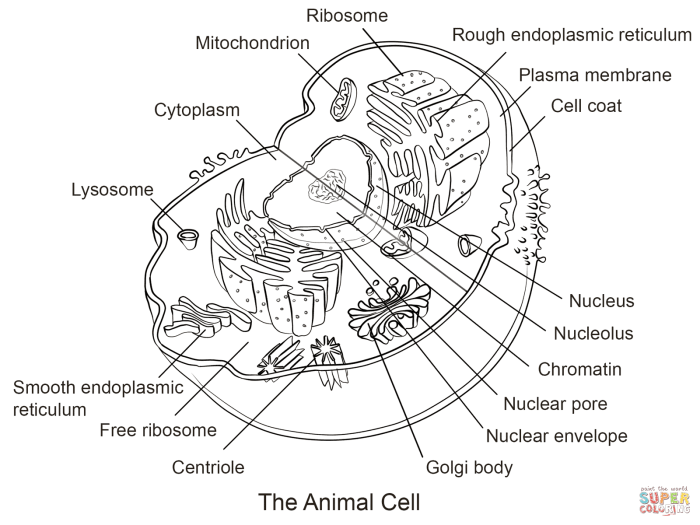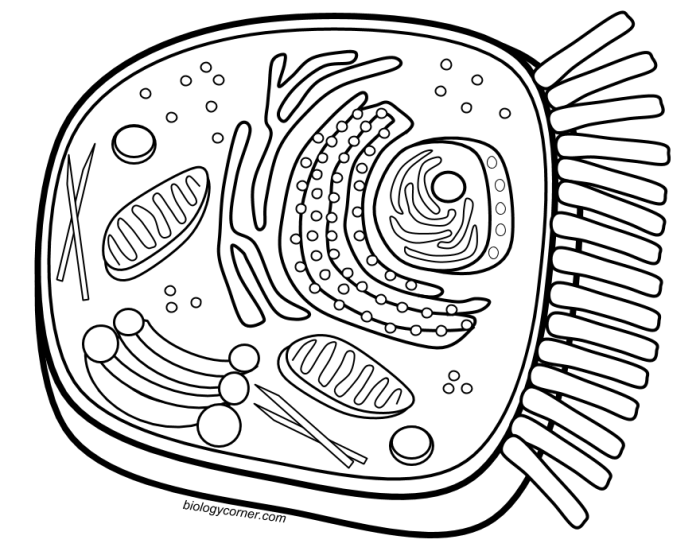Understanding the Search Term “Animal Cell Coloring Page 77”

The search term “Animal Cell Coloring Page 77” suggests a specific request for a particular coloring page depicting an animal cell. The number 77 likely refers to a page number within a larger workbook, textbook, or online collection of coloring pages. Alternatively, it could be an internal identifier used by a website or educational resource to catalog a specific illustration.
Understanding the context behind this number is key to interpreting the user’s intent.The various ways this search term might be used highlight the diverse applications of such educational resources.
User Groups and Their Search Intent
Teachers might use this term to locate a specific page for a lesson plan, ensuring consistency across student materials. For instance, a teacher might have a curriculum that explicitly references “Coloring Page 77” to reinforce a specific concept about animal cell organelles. Parents, on the other hand, might search for this term to supplement their child’s learning at home, providing a fun and engaging activity related to their biology studies.
Students themselves might use the term if they have lost their copy of a worksheet or need to access a specific page for revision. The search implies a need for a pre-existing resource with a known identifier, rather than a general request for animal cell coloring pages.
After completing your detailed study of the animal cell coloring page 77, perhaps you’d like to explore a broader range of animal life. For a change of pace, consider using some free african animal coloring pages to further your appreciation of the natural world’s diversity. Returning to page 77, remember to carefully label all the organelles within the animal cell for a comprehensive understanding.
Types of Animal Cells Represented
A coloring page identified as “77” could depict various animal cells, depending on the educational level and focus of the material. It might show a generalized animal cell, illustrating basic organelles like the nucleus, cytoplasm, mitochondria, and cell membrane. Alternatively, it could focus on a specific type of animal cell, such as a nerve cell (neuron) with its characteristic long axon and dendrites, a muscle cell (myocyte) showcasing its striated structure, or a red blood cell (erythrocyte) with its biconcave shape.
The illustration might also highlight specialized features of the cell, such as cilia or flagella, depending on the cell type and the learning objectives. The complexity of the illustration would vary based on the target audience, ranging from simplified diagrams for younger children to more detailed representations for older students. For example, a page might focus on the detailed internal structures of a neuron for a high school biology class, whereas a simpler diagram would be suitable for elementary school children.
Content Ideas for an Animal Cell Coloring Page
Designing an engaging and educational animal cell coloring page requires careful consideration of the organelles to be included and the complexity level suitable for the target audience. A well-designed coloring page can effectively aid in learning about the intricate structures within an animal cell. The following sections detail content ideas to achieve this.
Animal Cell Organelles and Their Functions
Understanding the roles of different organelles is crucial for comprehending the overall function of an animal cell. The table below lists five key organelles, their functions, and suggestions for their depiction on a coloring page.
| Organelle | Function | Color Suggestion | Coloring Page Depiction |
|---|---|---|---|
| Nucleus | Contains the cell’s DNA and controls cell activities. | Dark purple | A large, round shape in the center. |
| Cell Membrane | Controls what enters and leaves the cell. | Light blue | A thin, outer boundary surrounding all other organelles. |
| Cytoplasm | Gel-like substance filling the cell, supporting organelles. | Light yellow | Fills the space between the organelles. |
| Mitochondria | Powerhouse of the cell; produces energy (ATP). | Bright red | Bean-shaped structures scattered throughout the cytoplasm. |
| Ribosomes | Synthesize proteins. | Dark green | Small dots scattered throughout the cytoplasm, possibly clustered around the endoplasmic reticulum (if included). |
Animal Cell Illustration Design
The illustration should depict a simplified yet accurate representation of an animal cell. The cell will be roughly circular, with the nucleus centrally located and a dark purple color. The cell membrane, a light blue Artikel, encloses the entire cell. The cytoplasm, a light yellow color, fills the space between organelles. Bright red bean-shaped mitochondria are scattered throughout the cytoplasm.
Dark green dots representing ribosomes are also dispersed, possibly clustered near the (optional) endoplasmic reticulum (a light green network). The overall style should be cartoonish and appealing to children.
Complexity Levels for Animal Cell Coloring Pages
Different complexity levels cater to various age groups and skill levels.Beginner: This level includes only the nucleus, cell membrane, and cytoplasm. Simple shapes and large spaces for coloring are used.Intermediate: This level adds mitochondria and ribosomes. The organelles are slightly more detailed, but still easy to color within their boundaries.Advanced: This level includes all organelles mentioned previously, potentially adding the endoplasmic reticulum, Golgi apparatus, and lysosomes.
More intricate shapes and smaller details make coloring more challenging.
Educational Value and Applications: Animal Cell Coloring Page 77

Coloring pages, seemingly simple tools, offer a surprisingly effective method for teaching complex biological concepts, especially to younger learners. The act of coloring engages children actively, transforming passive learning into a hands-on experience that fosters better retention and understanding. This is particularly true when applied to subjects like cell biology, which can be initially challenging to grasp due to its abstract nature.
Animal cell coloring pages, in particular, provide a visual and tactile pathway to comprehending the intricate structures and functions within a cell.The educational benefits of using animal cell coloring pages extend across various age groups. For younger children (preschool to early elementary), the focus is primarily on recognizing and naming the basic components of an animal cell, such as the nucleus, cell membrane, and cytoplasm.
The vibrant colors and simple illustrations help them associate these terms with their visual representations. Older children (upper elementary and middle school) can delve deeper, learning about the functions of each organelle and understanding their interconnectedness within the cell. This can involve labeling the organelles, coloring them with specific colors to represent their roles, or even creating diagrams that illustrate cellular processes like protein synthesis.
High school students can use advanced coloring pages with more detailed structures and incorporate information about cell division, specialized cells, and the relationships between animal cells and other biological systems.
Age-Specific Learning Outcomes
Animal cell coloring pages can be adapted to suit different age groups, leading to varied learning outcomes. For example, a preschooler might simply color the different parts of the cell, while a high school student might use the coloring page as a base for a detailed diagram illustrating cellular respiration. The level of detail and the complexity of the associated activities should be tailored to the child’s developmental stage and existing knowledge.
Younger students benefit from simple, clearly labeled diagrams and activities focused on recognition and basic understanding. Older students can engage in more complex activities, such as creating 3D models of cells based on the coloring page or researching and presenting information about specific organelles.
Integration into Broader Lesson Plans
An animal cell coloring page can serve as a valuable component within a comprehensive lesson plan on cell biology. It can be used as an introductory activity to spark interest and provide a visual overview of the topic. Following the coloring activity, students can engage in discussions, quizzes, or hands-on experiments to reinforce their understanding. For instance, after coloring, students could research the functions of specific organelles and present their findings to the class.
The coloring page could also serve as a visual aid during lectures or discussions, providing a readily accessible reference point for students. Furthermore, the coloring activity can be followed by a more in-depth study of cell processes, such as cellular respiration or mitosis, using the colored diagram as a visual aid.
Applications in Diverse Educational Settings
Animal cell coloring pages are adaptable to various educational settings. In a classroom setting, they can be used as part of a group activity, encouraging collaboration and peer learning. The teacher can guide students through the coloring process, answering questions and providing further explanations. In homeschooling environments, the coloring page offers a flexible and engaging learning tool that parents can use to supplement their curriculum.
The parent can adapt the activity to the child’s pace and learning style, making it a personalized learning experience. Furthermore, these coloring pages are also valuable resources for after-school programs, summer camps, and museums that offer educational activities related to science and biology. The visual nature of the coloring page makes it accessible to a wide range of learners, including those with different learning styles and abilities.
Accessibility and Inclusivity

Creating an accessible and inclusive animal cell coloring page requires careful consideration of various factors to ensure that all learners, regardless of their abilities or learning styles, can engage with and benefit from the activity. This includes addressing potential visual, motor, and cognitive challenges, as well as promoting a diverse and representative depiction of the subject matter.Designing an engaging and informative coloring page necessitates addressing potential accessibility barriers and incorporating inclusive practices.
This approach ensures that the learning experience is beneficial and enjoyable for all students, regardless of their individual needs and learning styles. The goal is to create a resource that is both educational and universally accessible.
Visual Accessibility
Visual accessibility focuses on making the coloring page easily perceivable by individuals with visual impairments or low vision. This can be achieved through several strategies. For example, using a high contrast between the lines and the background will improve visibility. Bold, clearly defined lines will aid those with low vision. Furthermore, providing a larger print version of the coloring page can greatly improve accessibility for those who need more space between elements.
Finally, offering the coloring page in various formats, such as a digital version that allows for adjustments to font size and contrast, can increase its usability for a wider range of learners.
Motor Skill Accessibility, Animal cell coloring page 77
Learners with limited fine motor skills may find traditional coloring challenging. To accommodate this, consider providing variations of the coloring page. A simplified version with fewer intricate details could be offered, reducing the level of fine motor control required. Alternatively, a larger print version with thicker lines would make coloring easier. Digital versions allow for alternative input methods, such as using a larger stylus or even voice-activated coloring tools.
Cognitive Accessibility
Cognitive accessibility focuses on ensuring the coloring page is understandable and engaging for learners with various cognitive abilities. This involves using clear and concise labels for each part of the cell. The use of simple language and avoiding overly complex visual representations is essential. Providing additional support materials, such as a simplified diagram or a glossary of terms, can also aid understanding.
Moreover, incorporating interactive elements, such as labeling activities or matching games related to the cell’s components, could enhance engagement for learners with diverse cognitive needs.
Inclusive Representation
To promote inclusivity, the coloring page should accurately represent the diversity of life. Avoiding stereotypes and promoting accurate scientific representation is crucial. For instance, if the cell contains organelles with specific functions, their depiction should be scientifically accurate and avoid anthropomorphic representations that may lead to misconceptions. The coloring page should be free from any bias or stereotypes that might alienate or exclude certain learners.
